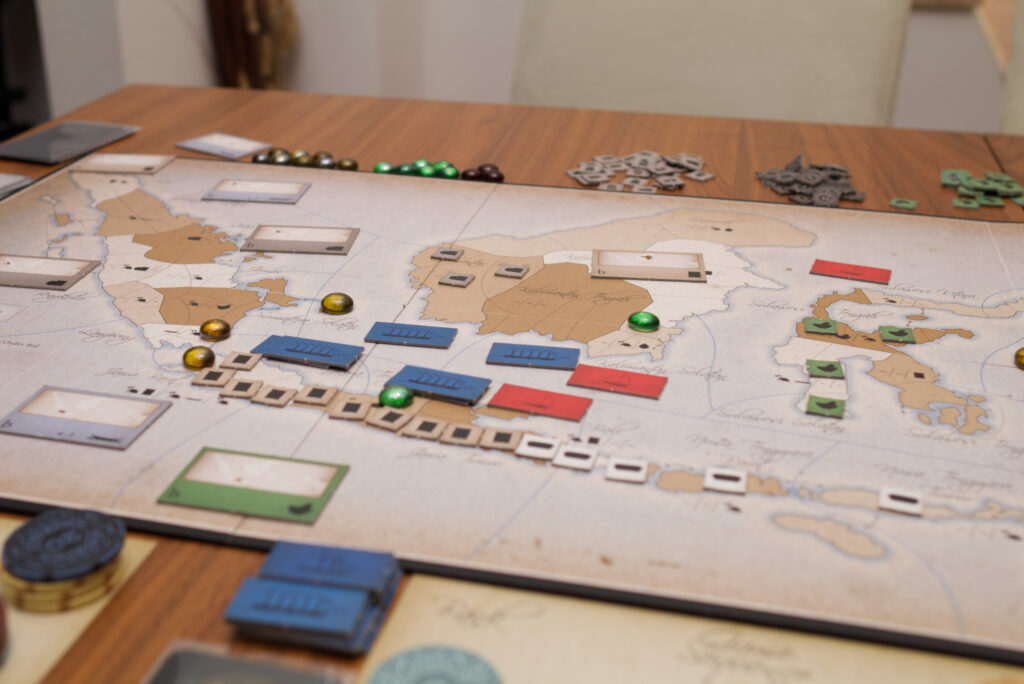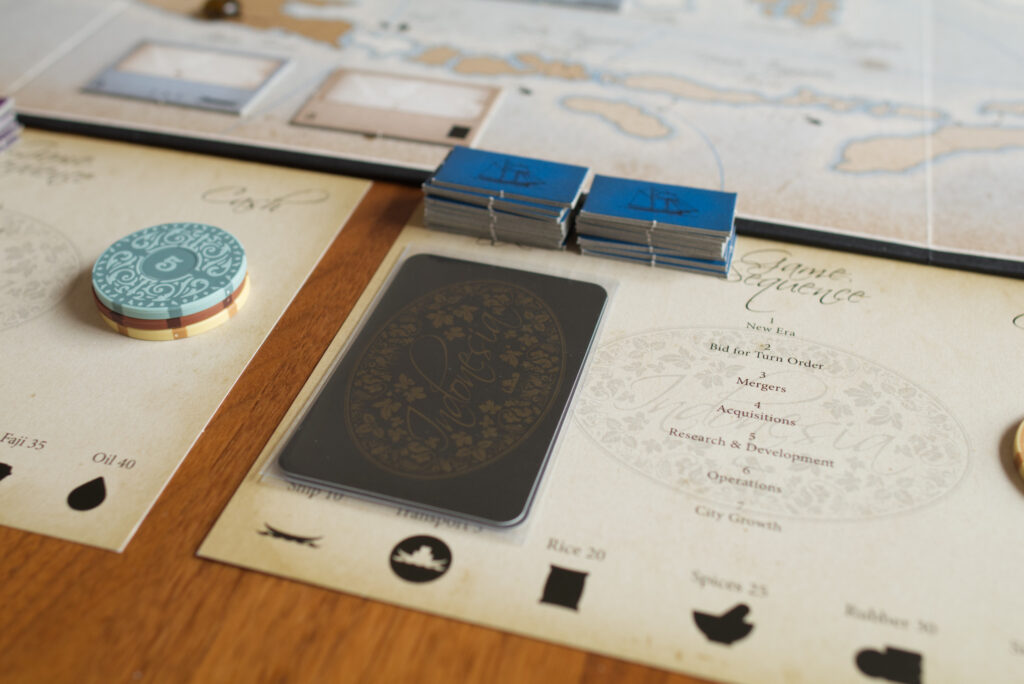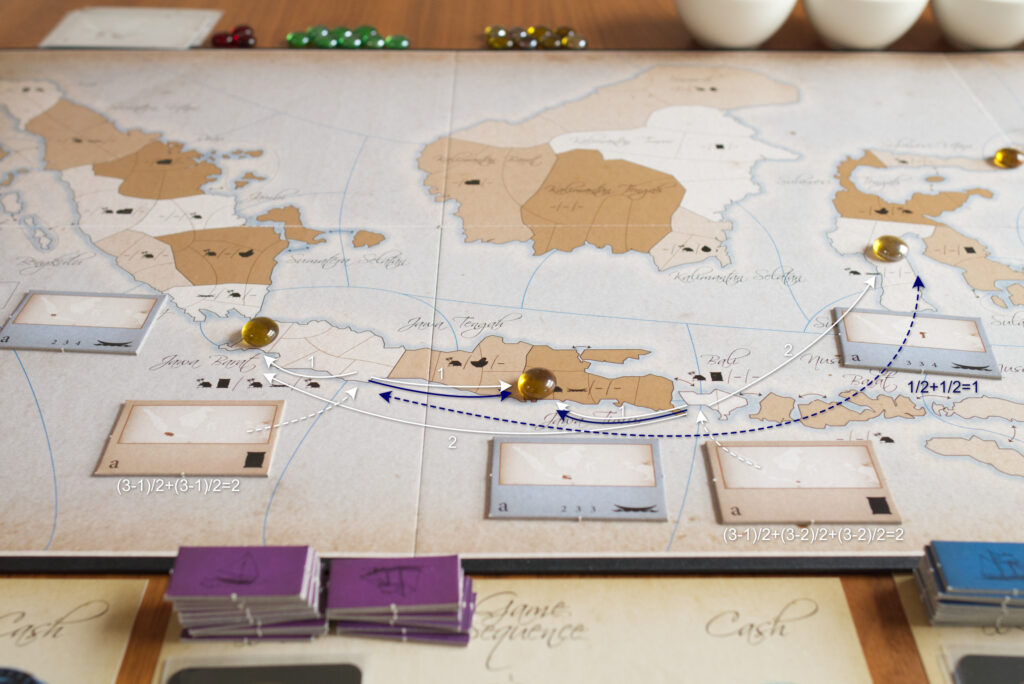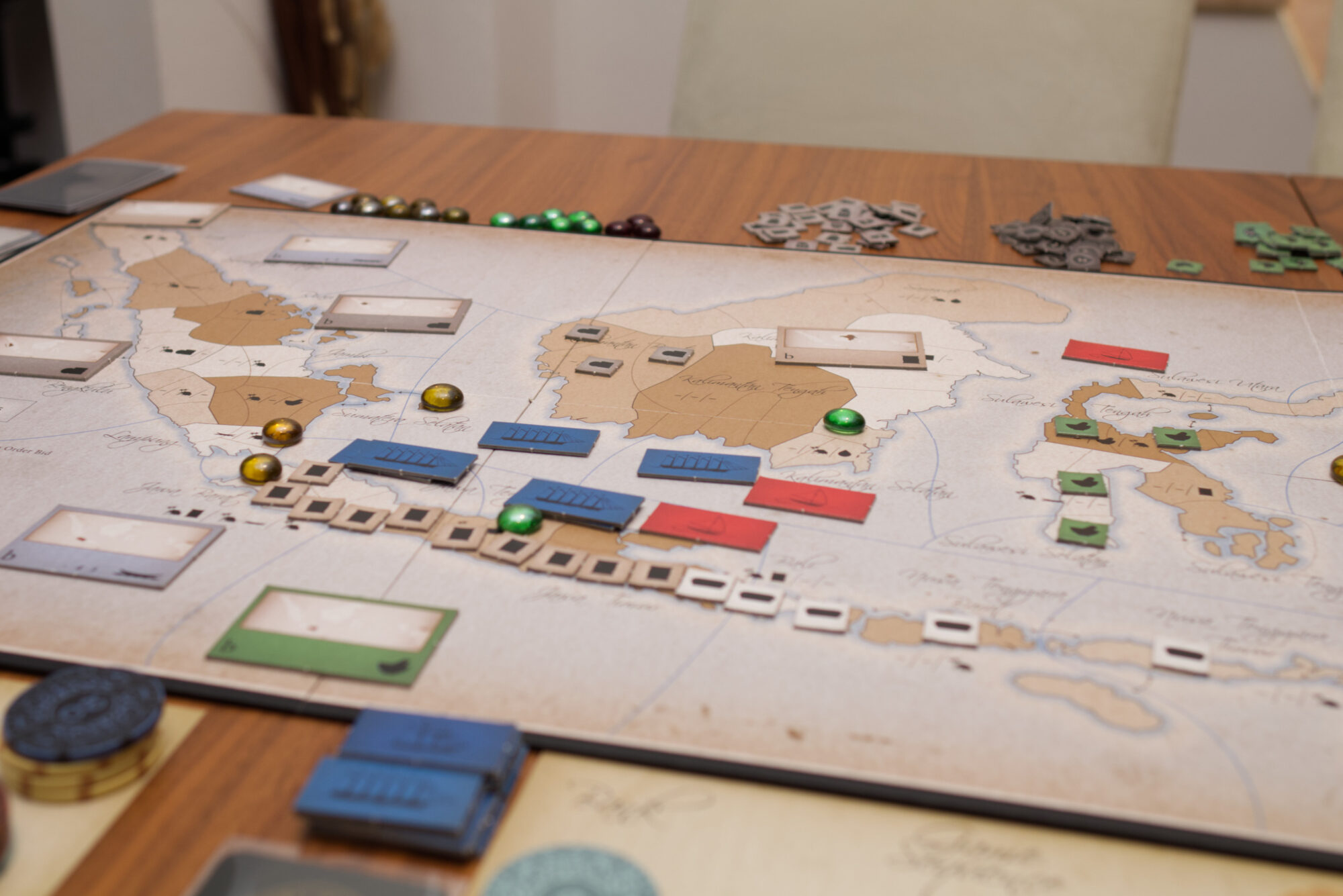I recently picked up a copy of Splotter’s Indonesia but faced a similar problem to when I got Horseless Carriage: I’m super intrigued but have a hard time to get this to the table with my group of friends. It’s got a long play time, requires repeated plays, graphics are … well … “Splotter-esque”. So of course I started designing my own automa.
This variant is still very much in development. It’s mainly based on strategy guides I’ve found on BGG, playthroughs such as the one by Heavy Cardboard, and my own observations. It already should provide a pleasant playing experience with some plausible reactions from the automa, but I’m still working on balancing everything and especially tweaking the bidding during mergers. If you have the chance to give it a try, let me know what you think! If there’s any situation the automa does something weird, please also send me a photo of the board state. Enjoy!
Last updated: Mar 31, 2024

Story
The seas around Indonesia get crowded. Local businesses are setting up shop, subsidised by their governments in an attempt to drive out foreign investors. Rumours even have it that they are planning to collude against you where they can. Will your job get harder or does the competition just present new opportunities for you to exploit?
General
All normal game rules apply! There is no additional material required except for a couple of six-sided dice. When it is an automa’s turn to make a decision, consult the section below that corresponds to the current phase. Most are a “drilling-down” set of priorities. Continue applying the individual preferences top to bottom to filter out options until only one choice is left or the description specifies a tie breaker (usually a roll of the die). E.g. when picking a place for a new city, apply preference rule 1 which should reduce the number of options, then rule 2 which further reduces the number of options, and so on. If a rule doesn’t apply to any of the still valid options, simply ignore it.
Note that Indonesia is a strategically rich, dynamic game and capturing the cleverness of a human player is next to impossible. This automa design is therefore intended as a compromise between competitiveness and ease of use. It tries to make plausible choices while still staying unpredictable. It may not always play optimally but when playing against multiple automa opponents at least one should pose a good challenge in every play. If you ever see a particularly good move the automa could do (or prevent it from making a terrible mistake), feel free to overrule it.
Setup
Choose a player count. For a solo game, four parties (one human, three automa) is recommended, but the automa can also be used for low player counts (e.g. 2 humans plus 1-3 automa). Setup works as normal. When dealing era cards to an automa, put them on the bank side of their player aid as a face-down deck, C-card at the bottom, A-card a the top.
Choose a difficulty:
- Easy: no modifications
- Normal: at the start of each round, give 10 rupiah to each automa (the government subsidies)
- Hard: at the start of each round, give 10 rupiah to each automa. In addition, each automa starts with merger level 2.

Phase 1: New Era
If it is the beginning of a new era, reveal the top card from the automa’s era deck (which should match the letter of the current era). Apply the following preferences to chose the province the automa places the new city in:
- If the automa owns production companies, it prefers provinces where one of their companies would already be connected to the city (via ships).
- If it has shipping companies, it prefers provinces not already connected to its ships but where it is the closest shipping company to it. If none such exists, prefer farthest province away from any ship.
- If there are still multiple provinces left, roll a D6 to pick from those provinces (1 being the region farthest to the west, counting east)
To choose the location within the selected province:
- If there are locations available that are connected to two sea regions, roll a D6. 1-3 the automa will pick from those locations, 4-6 the automa picks from the rest of the locations.
- If the city can be placed such that it cuts off an opponent’s plantation from further expanding, the automa will do so.
- If there are still multiple options left, roll D6 to pick from those locations (1 being location farthest to the west, counting east)
Note: as per standard rules, cities can only be placed in locations that have a coast line and no city can be placed in a province that already has a city.
Phase 2: Bid Turn Order
The automa’s bidding behaviour changes depending on whether or not a human player has already placed a bid:
- If no human has made a bid yet:
- Roll 3D6 to calculate the bid, modify by:
- +2D6 for era B – or – +3D6 for era C
- +1D6 if it has an unconnected production company and it could connect it to a city by acquiring a still available shipping company (note: requires unfilled slot)
- +1D6 it has no production company but one is available (and it has an unfilled slot for it) that it could connect with one of its own shipping companies
- Count number of sixes and ones and calculate the difference. If positive, roll that many additional dice. If negative, remove that many dice, starting from the highest value ones. Example: roll was 1, 1, 3, 5, 6, differences is -1 so the 6 is removed and the total value us 1+1+3+5=10
- Divide value by two for every step it is in front of every human player on the turn order bid track.
- Roll 3D6 to calculate the bid, modify by:
- If at least one human player has already made a bid:
- Use highest bid by a human player as base value for bid. Divide by two for every step it is in front of every human player on the turn order bid track.
- Roll 1D6
- +1 (point, not die) if it has an unconnected production company and it could connect it to a city by acquiring a shipping company (note: requires unfilled slot)
- +1 it has no production company but one is available that it could connect with one of its own shipping companies
- If the modified value is higher than 3, add that value to the base values as calculated in the first step. If lower than 4, subtract that value from bid.
If the automa is the last player to make a bid:
- Adjust bid so automa beats next lowest bid only by one (automa doesn’t spend more than necessary)
- If bid is equal to that of a human player, add one to the bid (automa tries to get in front of human if it is that cheap to do so)
Phase 3: Mergers
The automa respects normal rules regarding the required R&D and minimum bid. It will propose merges according to the following criteria:
- End of game: If the number of open player slots is high enough to trigger end of game, only propose merges of two companies the automa owns itself (=a “self-merge” to free up a slot).
- Don’t merge two opponents’ companies if a human player that can bid (=has required slots) has >20% more cash than automa.
- Prefer mergers that create a bigger company irrespective of who owns the companies (even a self-merge). The automa will first consider the number of tokens involved, then value of the merged company (tokens times price). It however only counts tokens that can currently be shipped (e.g. a 5 rice company is only connected to a single shipping company with hull two, so it will count it as a 2 rice company).
- Don’t merge two shipping companies if:
- the automa would end up with more than one region where it has two ships it owns in it (=prevent too much overlap)
- it doesn’t extend the longest route between a producer and a city when compared to before the merge. Ignore this for self-merges.
- If multiple equally valuable options exist, pick the one that is more profitable (money the company would generate this round if nothing changes on the board. To simplify, ignore that other players may deliver to cities before the automa)
The automa’’s bid will be calculated as follows:
- It always starts by bidding the minimum bid unless it is a merger of two companies it itself owns (=self-merge). In that case it starts with the maximum bid it can make.
- If all human players have dropped out, no automa will raise the bid (as they are colluding against you).
- If it has to raise the bid:
- It estimates the rough expected income per turn of the merged company by checking connected cities for how many of the produced goods it might actually be able to sell, assuming it would be first player and no one else satisfies the cities’ demands and respecting hull capacities. Multiply that number by the value of the good minus an expected shipping cost of 10 per good.
- Roll X D6 where X is the current bid divided by the income estimate, rounded up.
- -1D6 if all humans have an R&D merge level lower than the number of deeds of the merged company (=is safe from being immediately merged again next round)
- If any 5 or 6 was rolled, it passes and steps out of the bidding process. Otherwise it increases the bid by one increment (=number of involved tokens).
If a human player raises the bid, there is a chance the automa get intimidated:
- Roll X D6 where X is the number of increments the bid was raised.
- If any 5 or 6 was rolled, all automa pass and step out of the bidding process.
If a Siap Faji company was created, preserve locations according to the following order:
- Preserve access to as many sea regions as possible
- Preserve locations that are closer to a city (in shipping distance)
- Preserve locations that opponents could claim for their companies
- If there are still multiple options, roll D6 to figure out region, numbering the west-most option as 1 and counting up towards the east.
Phase 4: Acquisition
If the automa has an empty slot, it will pick a company to acquire. For each available company, figure out it’s “value”:
- For production companies:
- Check the three closest cities that are either already connected to the company or could be connected if a shipping company (owned by someone or still available) would expand optimally (respecting era limits). Each counts a positive base value (3 for rice, 4 for spice, 5 for rubber, etc) minus the distance to the city (via ships), multiplied by city size.
- A city counts half if connection is not complete yet.
- There are no penalties for a city if it can use ships the automa owns itself.
- Check the three closest cities that are either already connected to the company or could be connected if a shipping company (owned by someone or still available) would expand optimally (respecting era limits). Each counts a positive base value (3 for rice, 4 for spice, 5 for rubber, etc) minus the distance to the city (via ships), multiplied by city size.
- For shipping companies:
- If it would automatically be connected to one of the automa’s production companies: Check era limit of shipping company and find route that would connect the most cities that aren’t already connected to one of the automa’s ships. Value is the sum of the city size or ship hull, whichever is smaller.
- If it would not be automatically connected to one of the automa’s production companies:
- check era limit and find longest possible route between a city and a production company the automa doesn’t own (either on the board or still available company).
- For each production company on that route, add the amount of ships it would use to sell as much of its goods as possible (respecting hull size and city size, also counting ships multiple times if used for multiple goods). Ignore that different companies might compete for the same city demand.
- Count a connection half if a production company is not on the board yet (=still available) – or – an alternativ connection exists (=some other player has build a connecting ship line) – or – if creating the connection requires expanding into a region the automa already has a ship in.
If there are multiple best options, roll a D6 to randomly decide which it picks. If there is a single best option, roll a D6. 1-4 it picks the best option, 5-6 it picks one of the second best options (use new die roll to break any ties).

Example: in the image above, the left rice company has a value of 2 because if optionally placed (and the available shipping companies are also optionally build), it could connect to two cities each with a distances of a single ship. But since both ships don’t exist yet, the value is halved. The right rice company could potentially connect to three cities, but two of these connections would be distance two.
For the shipping company on the right, the longest possible connection between a city and a production company would be to place ships in right, bottom right, and bottom center sea regions. This would potentially connect two production companies with three cities. However, if the company has only hull 1, both rice companies would only sell a single good, both with distance 1 (ignoring the limited city demand). If the hull would be two, the left would sell one with distance 1 and the other with distance 3, and the right rice company 1 and 2, raising the shipping company’s value. It would also raise if one of the rice companies would already have been acquired and exist on the board.
To choose the location to start the company in :
- Production company:
- Prefer maximum total demand of cities already connected.
- Prefer access to most sea regions
- Prefer location closest to a sea region that contains a ship.
- Prefer location closest to a sea region where an existing shipping company can still expand to.
- It there are multiple options left, decide by rolling a die.
- Shipping company:
- Prefer placement so that the optional route as calculated above can be build
- Prefer connecting maximum of existing producers and cities with the first ship.
- Prefer placement so that maximum connections between a produce and city can be made with one expansion of the shipping company.
- If still multiple options left, decide by rolling a die.
Phase 5: Research & Development
First, check for the following hard criteria:
- If the end of game has been triggered, the automa increases its own hull.
- If a new era will start next round and the automa has neither an open slot nor high enough merge level to do a merge that includes one of it’s own companies, it takes slots.
- If it would benefit from increasing a player’s hull (even an opponent’s) to ship more of its production, roll a die. If the number is a one, it won’t do it at all. If the number is equal or less the additional products it could ship (with a profit) using the bigger hull, it will increase the hull of that player.
In all other cases, roll a D6 to decide how it will spend it’s R&D:
- 1 = Turn order bid (re-roll if it doesn’t have at least 2 slots)
- 2 = Slots (re-roll if it already has an empty slot)
- 3 = Merger (re-roll if it’s merger level is already higher than slots, e.g. merge 3 while only owning 2 slots – or – there is no such merger it could propose next round, e.g. doesn’t have enough money for minimum bid of a merger-3)
- 4 = Expansion (re-roll if none of its companies can do that much expansion – or – it has a production company that is not connected to any city – or – it would raise its expansion level over both slots and merger)
- 5 = Hull (re-roll if it doesn’t own a shipping company – or – isn’t connected to a production company that will have to use a 3 (or more) ships long connection to ship its goods.
- 6 = Slots or Merger, whichever it has less off (in case of tie, increase slots)
Phase 6: Operations
To pick which company to operate first, it will use the following order:
- It prefers to do highest possible sale first (unless it has no competition for it, then it does that sale last)
- Expand a shipping line so the longest route a producer has to use to sell through this turn increases
- Expand a shipping line so its own sales increase
- It pushed back negative sales as long as it can (hoping someone else might build a ship connection first)
- If still multiple options exist, roll a die.
It then executes the following:
- For a shipping company:
- If the company is connected to its own production, expand to connect to maximum demand (new cities, bigger cities first)
- With the era limit of the company in mind. Expand next step towards creating the longest connection possible between a city and an existing company.
- If multiple options exist on that route
- expand to connect producer with a city (if has neither, go for city first)
- then biggest new producer
- then new city (bigger city is better)
- then reducing distance to new producer (producer on board is considered better than a still available company)
- Ignore connections which are already provided by the automa via a different route
- For a production company:
- Choose most cost effective route to sell.
- When using its own shipping line, prefer shipping to cities that make shipping distance longer for others that sell the same product.
- Prefer to grow a city if possible (if multiple, choose closer to self and farther way from opponents)
- If equal options exist, prefer using an automa’s ships, then player with least money, then delivering to smallest number of cities.
- It will only pay for expansion if one of the following is true: it could immediately ship the extra production with the existing connections – or – will give access to new sea region – or – the company is smaller than three tokens and automa has more than 200 rupiah cash.
- It will expand in such a way that it gets closer to reaching a new sea region, otherwise build towards opponent company (to cut them off)
Phase 7: City Growth
Normal rules apply.
End of Game
All normal rules apply. You win if you have the most money.
